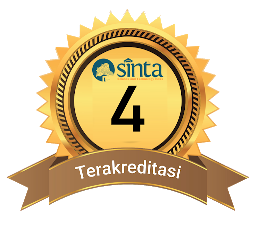Model Mental Mahasiswa Pada Fenomena Penghilangan Karat Melalui Elektrolisis
DOI:
10.29303/cep.v3i2.2104Published:
2020-11-19Issue:
Vol. 3 No. 2 (2020): NovemberArticles
Downloads
How to Cite
Abstract
Penelitian ini bertujuan untuk menggali model mental mahasiswa dalam memahami fenomena penghilangan karat melalui elektrolisis. Penelitian ini merupakan penelitian deskriptif dengan metode penelitian cross-section. Subyek penelitian adalah mahasiswa semester III dan V Program Studi Pendidikan Kimia FKIP Universitas Mataram yang dipilih dengan purposive sampling. Model mental mahasiswa digali menggunakan tes tertulis dan wawancara semistruktur. Model mental mahasiswa dianalisis menggunakan teknik constan comparative. Hasil penenlitian menunjukkan bahwa sebagian besar mahasiswa mengembangkan model mental inisial dalam memahami fenomena penghilangan karat melalui elektrolisis. Selain itu, ditemukan bahwa seiring dengan bertambahnya usia individu, model mental yang dikembangkannya mendekati model mental saintifik.
Kata Kunci: model mental, karat, elektrolisis.
References
Acar, B. and Tanhar, L. 2007. Effect Of Cooperative Learning Strategies On Studentsââ¬â¢ Understanding Of Concepts In Electrochemistry. International Journal of Science and Mathematics Education, 5: 349-373.
Chittleborough, G.D., Treagust, D. F., & Mocerino, M. 2002. Constraints to Development of First Year University Chemistry Studentsââ¬â¢ Mental Models of Chemical Phenomena. Teaching and Learning Forum. Focusing on Student.Cin, M. 2013. Undergraduate Studentsââ¬â¢ Mental Models of Hailstone Formation. International Journal of Environmental & Science Education, 8 (1): 163-174.
Coll R.K. & Treagust, D.F. 2003. Investigation of Secondary School, Undergraduate, and Graduate Learnersââ¬â¢ Mental Models of Ionic Bonding. Journal of Research in Science Teaching. 40 (5) : 464ââ¬â486
Garnett, P.J., Garnet, P. J., & Treagust, D. F. 1990. Implications of Research on Students' Understanding of Electrochemistry for Improving Science Curricula and Classroom Practice. International Journal of Scince Education, 12 (2): 147-156
Garnett, P.J & Treagust, D. F. 1992. Conceptual Difficulties Experienced by Senior High School Students of Electrochemistry: Electric Circuits and Oxidation-Reduction Equations. Journal of Research in Science Teaching; 29 (2): 121-124.
Jansoon, N., Coll, R. K., & Somsook, E. 2009. Understanding Mental Model of Dilution in Thai Students.
Johnstone, A.H. 1991. Why is Science Difficult to Learn? Things are Seldom What They Seem. Journal of Computer Assisted Learning, 7, 75ââ¬â83.
Kurnaz, M.A. & Eksi, C. 2015. An Analysis of High School Studentsââ¬â¢ Mental Models of Solid Friction in Physics. Educational Sciences: Theory & Practice, 15 (3): 787-795.
Kurnaz, M.A. & Emen, A.Y. 2014. Student Mental Models Related To Expansion And Contraction. Acta Didactica Napocensia, 7 (1): 59-67.
Laliyo, L.A.R. 2011. Model Mental Siswa Dalam Memahami Perubahan Wujud Zat. Jurnal Penelitian dan Pendidikan, 8 (1): 1-12.
Ozkaya, A.R., Uce, M., & Sahin, M. 2003. Prospective teachersÃÂ conceptual understanding of electrochemistry: Galvanic and electrolytic cells. U.Chem.Ed., 7: 1-12.
Radvansky, G.A., Gerard, L.D., Zacks, R.T., & Hasher, L. 1990. Younger and Older Adults' Use of Mental Models as Representations for Text MaterialsPsychology and Aging, 5 (2): 209-214.
Rapp, D.N. 2005. Mental Models: Theoretical Issues For Visualizations In Science Education. In J.K. Gilbert (Ed.), Visualization in Science Education (hal. 43-60). The Netherlands: Springer.
Sacco, K., Bucciarelli, M., & Adenzato, M. 2001. Mental Models and the Meaning of Connectives A Study on Childern, Adolescents and Adults.
Sunyono, Yuanita, L., Ibrahim, M. 2013. Keterkaitan Model Mental Mahasiswa Dengan Penguasaan Konsep Stoikiometri Sebelum Dan Sesudah Pembelajaran Dengan Model SiMaYang. Seminar Nasional Pendidikan Sains PPs 2013, Universitas Negeri Surabaya, 19 Januari 2013.
Vosniadou, S., & Brewer, W.F. 1992. Mental Models of The Earth: A Study of Conceptual Change in Childhood. Cognitive Psychology, 24: 535ââ¬â585.
Wang, C., & Barrow, L.H. 2011. Characteristic and Level of Sophistication: An Analysis of Chemistry Studentsââ¬â¢ Ability to Think with Mental Models. Research Science Education, Springer, 41(1): 561-586.
Author Biographies
Sunniarti Ariani, Program Studi Pendidikan Kimia, FKIP, Universitas Mataram
Effendy Effendy, Program Studi Magister Pendidikan Kimia, Pascasarjana Universitas Negeri Malang
Suharti Suharti, Program Studi Magister Pendidikan Kimia, Pascasarjana Universitas Negeri Malang
License
Authors who publish with Chemistry Education Practice agree to the following terms:
- Authors retain copyright and grant the journal right of first publication with the work simultaneously licensed under a Creative Commons Attribution License 4.0 International License (CC-BY-SA License). This license allows authors to use all articles, data sets, graphics, and appendices in data mining applications, search engines, web sites, blogs, and other platforms by providing an appropriate reference. The journal allows the author(s) to hold the copyright without restrictions and will retain publishing rights without restrictions.
- Authors are able to enter into separate, additional contractual arrangements for the non-exclusive distribution of the journal's published version of the work (e.g., post it to an institutional repository or publish it in a book), with an acknowledgement of its initial publication in Chemistry Education Practice.
- Authors are permitted and encouraged to post their work online (e.g., in institutional repositories or on their website) prior to and during the submission process, as it can lead to productive exchanges, as well as earlier and greater citation of published work (See The Effect of Open Access).






